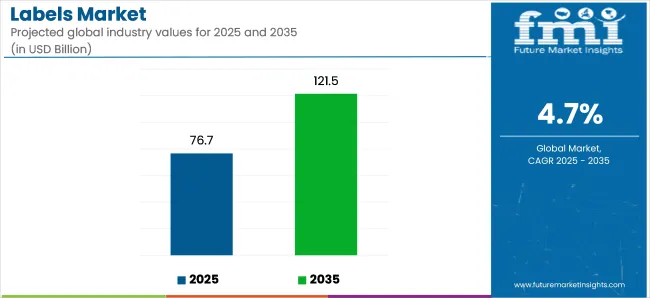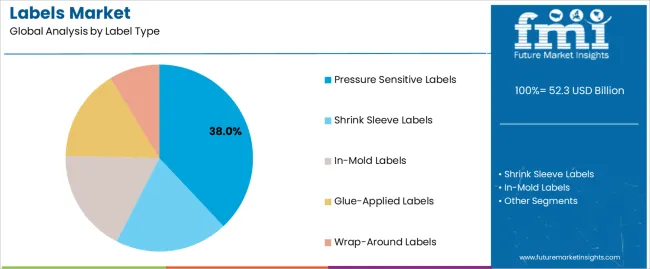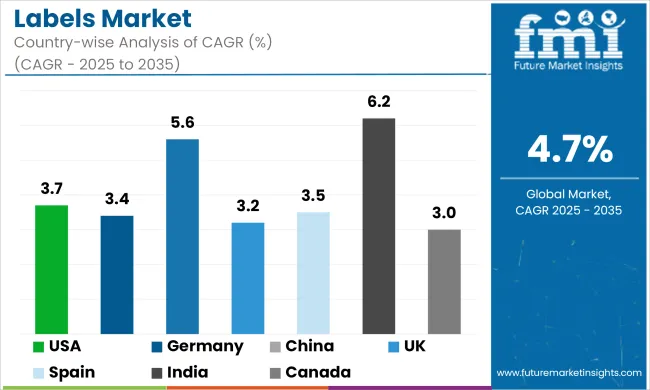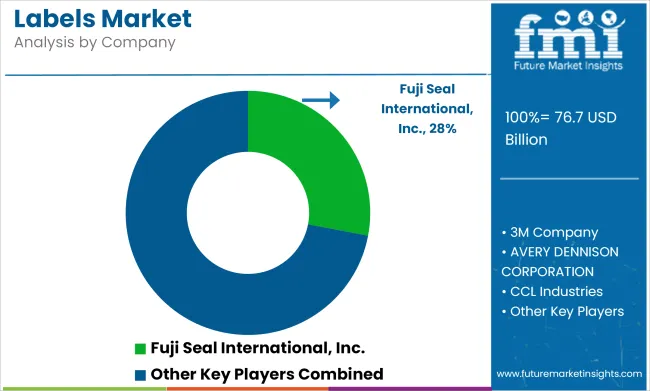The labels market stands at the threshold of a decade-long expansion trajectory that promises to reshape product identification and brand communication across multiple industries. The market's journey from USD 52.3 billion in 2025 to USD 89.7 billion by 2035 represents substantial growth, demonstrating the accelerating adoption of advanced labeling technology and premium identification solutions across retail, pharmaceutical, food & beverage, and industrial sectors.
The first half of the decade (2025-2030) will witness the market climbing from USD 52.3 billion to approximately USD 68.1 billion, adding USD 15.8 billion in value, which constitutes 42% of the total forecast growth period. This phase will be characterized by the rapid adoption of smart labeling solutions, driven by increasing e-commerce packaging requirements and the growing need for advanced tracking and identification systems worldwide. Enhanced adhesive capabilities and digital printing technologies will become standard expectations rather than premium options.
The latter half (2030-2035) will witness continued growth from USD 68.1 billion to USD 89.7 billion, representing an addition of USD 21.6 billion or 58% of the decade's expansion. This period will be defined by mass market penetration of intelligent labeling technologies, integration with comprehensive supply chain platforms, and seamless compatibility with existing packaging infrastructure. The market trajectory signals fundamental shifts in how brands approach product identification and consumer engagement, with participants positioned to benefit from growing demand across multiple label types and application segments.

| Period | Primary Revenue Buckets | Share | Notes |
|---|---|---|---|
| Today | Pressure sensitive labels (standard) | 38% | Retail packaging, product identification |
| Shrink sleeve labels | 24% | Beverage bottles, curved containers | |
| In-mold labels | 16% | Durable goods, automotive applications | |
| Glue-applied labels | 14% | Traditional packaging, cost-sensitive applications | |
| Multi-layer labels | 8% | Pharmaceutical, regulatory compliance | |
| Future (3-5 yrs) | Smart/RFID integrated labels | 28-32% | Supply chain tracking, inventory management |
| Digital printed pressure sensitive | 26-30% | Customization, short-run production | |
| Eco-friendly bio-based labels | 18-22% | Environmental regulations, brand positioning | |
| Security/tamper-evident labels | 12-16% | Anti-counterfeiting, product authentication | |
| Interactive/QR code labels | 8-12% | Consumer engagement, product information |
| Metric | Value |
|---|---|
| Market Value (2025) | USD 52.3 billion |
| Market Forecast (2035) | USD 89.7 billion |
| Growth Rate | 5.5% |
| Leading Technology | Pressure Sensitive Labels |
| Primary Application | Retail & Consumer Goods Segment |
The market demonstrates strong fundamentals with pressure sensitive label systems capturing a dominant share through advanced adhesive capabilities and versatile application optimization. Retail and consumer goods applications drive primary demand, supported by increasing e-commerce packaging and premium branding equipment adoption requirements. Geographic expansion remains concentrated in developed markets with established manufacturing cultures, while emerging economies show accelerating adoption rates driven by industrial growth and rising quality standards.
Primary Classification: The market segments by label type into pressure sensitive labels, shrink sleeve labels, in-mold labels, glue-applied labels, and wrap-around labels, representing the evolution from basic identification materials to sophisticated branding solutions for comprehensive product differentiation optimization.
Secondary Classification: Material segmentation divides the market into paper labels, plastic/polymer labels, metal labels, and fabric labels, reflecting distinct requirements for durability, application environment, and performance standards.
Tertiary Classification: Application segmentation covers food & beverage, pharmaceutical & healthcare, personal care & cosmetics, retail & consumer goods, industrial & chemical, and automotive sectors, while printing technology spans flexographic, digital, lithographic, and screen printing categories.
Regional Classification: Geographic distribution covers North America, Europe, Asia Pacific, Latin America, and Middle East & Africa, with developed markets leading technology adoption while emerging economies show accelerating growth patterns driven by manufacturing expansion programs.
The segmentation structure reveals technology progression from standard identification materials toward sophisticated tracking systems with enhanced functionality and interactive capabilities, while application diversity spans from consumer goods to industrial operations requiring precise labeling solutions.

Market Position: Pressure Sensitive Label systems command the leading position in the labels market with 38% market share through advanced adhesive features, including superior bonding capabilities, application versatility, and product identification optimization that enable manufacturers to achieve optimal brand presentation across diverse packaging and labeling environments.
Value Drivers: The segment benefits from manufacturer preference for reliable labeling systems that provide consistent adhesive performance, enhanced brand visibility, and quality optimization without compromising label integrity or affecting product presentation characteristics. Advanced adhesive engineering enables permanent bonding, visual appeal, and integration with existing packaging equipment, where adhesive performance and presentation consistency represent critical operational requirements.
Competitive Advantages: Pressure Sensitive Label systems differentiate through proven adhesive reliability, consistent bonding characteristics, and integration with automated application systems that enhance operational efficiency while maintaining optimal product identification standards suitable for diverse consumer and industrial applications.
Key market characteristics:
Shrink Sleeve Label systems maintain a 24% market position in the labels market due to their 360-degree coverage convenience and premium presentation advantages. These systems appeal to brands requiring full-surface decoration with superior graphics for diverse product packaging applications. Market growth is driven by brand preference, emphasizing visual impact and comprehensive coverage through optimized sleeve design.
In-Mold Label systems capture 16% market share through durable application requirements in automotive, appliance, and industrial equipment sectors. These applications demand integrated labeling systems capable of withstanding harsh environments while providing exceptional durability and permanent identification.

Market Context: Plastic/Polymer labels demonstrate market share 45.9% due to widespread adoption of durable labeling solutions and increasing focus on weather resistance, chemical compatibility, and long-term performance that maximizes label effectiveness while maintaining identification standards.
Appeal Factors: Polymer label operators prioritize durability, chemical resistance, and integration with diverse environmental conditions that enables optimized labeling operations across multiple application scenarios. The segment benefits from substantial industrial investment and harsh environment programs that emphasize the acquisition of polymer labels for durability optimization and performance assurance applications.
Growth Drivers: Industrial expansion programs incorporate polymer labels as standard components for equipment identification, while automotive growth increases demand for permanent labeling capabilities that comply with safety standards and minimize maintenance requirements.
Market Challenges: Higher material costs and processing complexity may limit standardization across different applications or environmental scenarios.
Application dynamics include:
Paper label applications capture market share through traditional packaging requirements in food & beverage, retail, and consumer goods sectors. These applications demand cost-effective labeling systems capable of operating with conventional printing equipment while providing effective brand presentation and operational simplicity capabilities.
Metal label applications account for niche market share, including luxury goods, automotive nameplates, and high-end appliances requiring premium identification capabilities for brand differentiation and durability optimization.
Market Position: Food & Beverage applications command significant market position with 7.2% CAGR through growing packaged food consumption trends and beverage industry expansion for brand differentiation.
Value Drivers: This application segment provides the ideal combination of regulatory compliance and brand presentation, meeting requirements for ingredient labeling, nutritional information, and marketing appeal without compromising food safety standards.
Growth Characteristics: The segment benefits from broad applicability across food manufacturers, automated labeling adoption, and established packaging programs that support widespread label usage and operational convenience.
Market Context: Pharmaceutical & Healthcare sectors dominate the market with 7.8% CAGR, reflecting the primary demand source for high-quality labels in medical applications and regulatory compliance scenarios.
Business Model Advantages: Healthcare applications provide direct market demand for traceable labeling materials, driving quality standards and safety innovation while maintaining regulatory compliance and patient safety requirements.
Operational Benefits: Medical applications include product identification, dosage information, and safety warnings that drive consistent demand for specialized labels while providing access to latest identification technologies.
| Category | Factor | Impact | Why It Matters |
|---|---|---|---|
| Driver | E-commerce packaging boom & online retail growth (shipping labels, product identification) | ★★★★★ | Exponential growth in online shopping creates massive demand for shipping and product labels; digital commerce drives packaging innovation and identification requirements. |
| Driver | Pharmaceutical industry expansion & regulatory compliance (drug labeling, safety requirements) | ★★★★★ | Strict regulatory requirements for medication labeling; aging population drives pharmaceutical demand requiring precise identification and safety information. |
| Driver | Smart packaging integration & IoT connectivity (RFID labels, tracking systems) | ★★★★☆ | Technology advancement enabling supply chain tracking; consumer demand for product information and authenticity verification drives smart label adoption. |
| Restraint | Raw material price volatility & supply chain disruptions (paper, adhesive costs) | ★★★★☆ | Commodity price fluctuations impact profit margins; global supply chain issues create cost pressures and availability concerns for label manufacturers. |
| Restraint | Digital alternatives & paperless solutions (QR codes, digital displays) | ★★★☆☆ | Growing adoption of digital information display; environmental concerns driving reduction in physical labeling for certain applications. |
| Trend | Personalization & variable data printing (customized labels, limited editions) | ★★★★★ | Brands leveraging personalized packaging for consumer engagement; digital printing technology enabling cost-effective customization and targeted marketing campaigns. |
| Trend | Anti-counterfeiting & security features (holographic labels, authentication technology) | ★★★★☆ | Rising product counterfeiting concerns; brand protection requirements driving adoption of security labels with authentication features and tamper-evident properties. |
The labels market demonstrates varied regional dynamics with Growth Leaders including China (7.9% growth rate) and India (8.4% growth rate) driving expansion through manufacturing growth and packaging modernization initiatives. Steady Performers encompass United States (5.2% growth rate), Germany (5.7% growth rate), and developed regions, benefiting from established manufacturing cultures and advanced labeling technology adoption. Emerging Markets feature Brazil (7.1% growth rate) and developing regions, where industrial expansion and consumer goods growth support consistent growth patterns.
Regional synthesis reveals North American markets leading technology innovation through smart labeling adoption and digital printing culture, while Asian markets demonstrate highest volume growth supported by manufacturing expansion and rising packaging standards. European markets show moderate growth driven by regulatory compliance requirements and quality enhancement integration.

| Region/Country | 2025-2035 Growth | How to win | What to watch out |
|---|---|---|---|
| China | 7.9 | Manufacturing scale; cost-effective smart solutions | Quality standardization; environmental regulations |
| India | 8.4 | Industrial expansion; affordable premium labels | Infrastructure limitations; skilled labor shortage |
| United States | 5.2 | Technology leadership; customization capabilities | Labor costs; regulatory complexity |
| Germany | 5.7 | Engineering excellence; automation integration | Energy costs; market saturation |
| Brazil | 7.1 | Regional partnerships; local manufacturing | Currency volatility; logistics challenges |
China establishes manufacturing-led growth through massive industrial infrastructure and comprehensive packaging development, integrating advanced labeling systems as standard components in manufacturing operations and export facilities. The country's 7.9% growth rate reflects explosive e-commerce adoption and domestic manufacturing industry expansion that mandates the use of quality identification systems in production and logistics facilities. Growth concentrates in major industrial centers, including Guangzhou, Shenzhen, and Shanghai, where manufacturing platforms showcase integrated labeling systems that appeal to companies seeking advanced product identification capabilities and export optimization applications.
Chinese manufacturers are developing domestically-produced labeling solutions that combine local production advantages with functional operational features, including enhanced adhesive performance and digital printing capabilities. Distribution channels through manufacturing supply chains and export partnerships expand market access, while industrial culture supports adoption across diverse production and logistics segments.
Strategic Market Indicators:
In Mumbai, Delhi, and Bangalore, manufacturers and packaging companies are implementing advanced labeling systems as standard identification for product quality and export applications, driven by increasing industrial investment and manufacturing programs that emphasize the importance of professional labeling. The market holds an 8.4% growth rate, supported by pharmaceutical industry expansion and consumer goods programs that promote quality labeling systems for commercial and export applications. Indian operators are adopting labeling solutions that provide consistent identification performance and regulatory compliance features, particularly appealing in industrial regions where product identification and export quality represent critical business requirements.
Market expansion benefits from growing middle-class consumption patterns and manufacturing proliferation that enable widespread adoption of professional labeling systems for production and retail applications. Technology adoption follows patterns established in textile and pharmaceutical sectors, where functionality and compliance drive procurement decisions and operational deployment.
Market Intelligence Brief:
United States establishes technology leadership through comprehensive manufacturing programs and advanced labeling culture development, integrating smart labeling systems across industrial and consumer applications. The country's 5.2% growth rate reflects established manufacturing consumption patterns and mature identification technology adoption that supports widespread use of advanced labeling systems in production and retail facilities. Growth concentrates in major industrial regions, including California, Texas, and the Midwest, where manufacturing culture showcases mature labeling deployment that appeals to companies seeking proven identification capabilities and brand presentation applications.
American manufacturers leverage established distribution networks and comprehensive product availability, including custom-printed labels and smart tracking options that create operational differentiation and competitive advantages. The market benefits from mature supply chain infrastructure and willingness to invest in quality labeling materials that enhance product presentation and identification optimization.
Market Intelligence Brief:
Germany's advanced manufacturing market demonstrates sophisticated labeling system deployment with documented performance effectiveness in automotive applications and industrial facilities through integration with existing production systems and quality infrastructure. The country leverages engineering excellence and automation standards to maintain a 5.7% growth rate. Industrial centers, including Bavaria, Baden-Württemberg, and North Rhine-Westphalia, showcase premium installations where labeling systems integrate with comprehensive manufacturing platforms and quality systems to optimize identification operations and production effectiveness.
German operators prioritize precision engineering and quality standards in labeling procurement, creating demand for certified products with advanced features, including automated application and integration capabilities. The market benefits from established engineering culture and willingness to invest in premium identification materials that provide superior performance benefits and adherence to quality standards.
Market Intelligence Brief:
Brazil's market expansion benefits from diverse industrial demand, including automotive manufacturing in São Paulo and consumer goods production, packaging establishment growth, and rising export requirements that increasingly incorporate advanced labeling solutions for product identification applications. The country maintains a 7.1% growth rate, driven by industrialization and increasing recognition of professional labeling benefits, including improved product presentation and enhanced export competitiveness.
Market dynamics focus on cost-effective quality labeling solutions that balance identification performance with cost considerations important to Brazilian manufacturers. Growing industrial base creates continued demand for modern labeling systems in new facility infrastructure and manufacturing modernization projects.
Strategic Market Considerations:
The European labels market is projected to grow from USD 16.8 billion in 2025 to USD 27.2 billion by 2035, registering a CAGR of 4.9% over the forecast period. Germany is expected to maintain its leadership position with a 31.2% market share in 2025, supported by its strong automotive industry and manufacturing excellence.
United Kingdom follows with a 19.8% share in 2025, driven by pharmaceutical sector growth and e-commerce expansion. France holds a 18.6% share through luxury goods packaging and food industry applications. Italy commands a 15.4% share, while Spain accounts for 8.7% in 2025. The rest of Europe region is anticipated to gain momentum, expanding its collective share from 6.3% to 7.8% by 2035, attributed to increasing industrial modernization in Nordic countries and emerging manufacturing establishments implementing advanced labeling programs.

| Stakeholder | What they actually control | Typical strengths | Typical blind spots |
|---|---|---|---|
| Global manufacturers | Production capacity, R&D investment, distribution networks | Scale efficiency, technology leadership, global reach | Local customization; emerging market penetration |
| Technology innovators | Smart label development; RFID integration; digital printing capabilities | Innovation leadership; patent portfolio; performance differentiation | Mass production costs; distribution scale |
| Regional specialists | Local manufacturing, market proximity, competitive pricing | Cultural understanding; quick response; cost advantage | Technology gaps; international expansion |
| Converting specialists | Custom printing; finishing capabilities; value-added services | Specialization expertise; customer relationships; flexibility | Volume scale; raw material costs |
| Material suppliers | Substrate technology, adhesive development, coating solutions | Technical expertise; material innovation; supply reliability | Market application knowledge; end-user access |
| Item | Value |
|---|---|
| Quantitative Units | USD 52.3 billion |
| Label Type | Pressure Sensitive Labels, Shrink Sleeve Labels, In-Mold Labels, Glue-Applied Labels, Wrap-Around Labels |
| Material | Paper, Plastic/Polymer, Metal, Fabric |
| Printing Technology | Flexographic, Digital, Lithographic, Screen Printing |
| Application | Food & Beverage, Pharmaceutical & Healthcare, Personal Care & Cosmetics, Retail & Consumer Goods, Industrial & Chemical, Automotive |
| Regions Covered | North America, Europe, Asia Pacific, Latin America, Middle East & Africa |
| Countries Covered | United States, China, Germany, India, United Kingdom, Brazil, Canada, Japan, France, Italy, and 40+ additional countries |
| Key Companies Profiled | Avery Dennison Corporation, CCL Industries Inc., Multi-Color Corporation, UPM Raflatac, 3M Company, Constantia Flexibles Group |
| Additional Attributes | Dollar sales by label type and material categories, regional adoption trends across North America, Asia Pacific, and Europe, competitive landscape with labeling manufacturers and technology suppliers, consumer preferences for product identification and brand presentation, integration with packaging systems and manufacturing processes, innovations in smart labeling technology and digital printing, and development of eco-friendly labeling solutions with enhanced performance and identification capabilities. |
The global labels market is estimated to be valued at USD 52.3 billion in 2025.
The market size for the labels market is projected to reach USD 89.7 billion by 2035.
The labels market is expected to grow at a 5.5% CAGR between 2025 and 2035.
The key product types in labels market are pressure sensitive labels, shrink sleeve labels, in-mold labels, glue-applied labels and wrap-around labels.
In terms of material, paper segment to command 45.9% share in the labels market in 2025.






Full Research Suite comprises of:
Market outlook & trends analysis
Interviews & case studies
Strategic recommendations
Vendor profiles & capabilities analysis
5-year forecasts
8 regions and 60+ country-level data splits
Market segment data splits
12 months of continuous data updates
DELIVERED AS:
PDF EXCEL ONLINE
Labels, Tapes And Films Market Size and Share Forecast Outlook 2025 to 2035
Competitive Overview of Labels Companies
USA Labels Market Size and Share Forecast Outlook 2025 to 2035
Market Share Distribution Among USA Labels Providers
Foam Labels Market Trends and Growth 2035
Market Share Breakdown of Foil Labels Manufacturers
Foil Labels Market Analysis by Metal Foils & Polymer-Based Foils Through 2035
Kraft Labels Market Size and Share Forecast Outlook 2025 to 2035
HAZMAT Labels Market Growth and Forecast 2025 to 2035
In-mold Labels Market Size and Share Forecast Outlook 2025 to 2035
Printed Labels Market Size and Share Forecast Outlook 2025 to 2035
Sheeted Labels Market Size and Share Forecast Outlook 2025 to 2035
QR Code Labels Market Size and Share Forecast Outlook 2025 to 2035
Braille Labels Market Size and Share Forecast Outlook 2025 to 2035
Syringe Labels Market Size and Share Forecast Outlook 2025 to 2035
Thermal Labels Market Analysis - Size, Growth & Outlook 2025 to 2035
Competitive Landscape of In-Mold Labels Providers
Competitive Breakdown of Braille Labels Manufacturers
Canning Labels Market
Die Cut Labels Market

Thank you!
You will receive an email from our Business Development Manager. Please be sure to check your SPAM/JUNK folder too.
Chat With
MaRIA